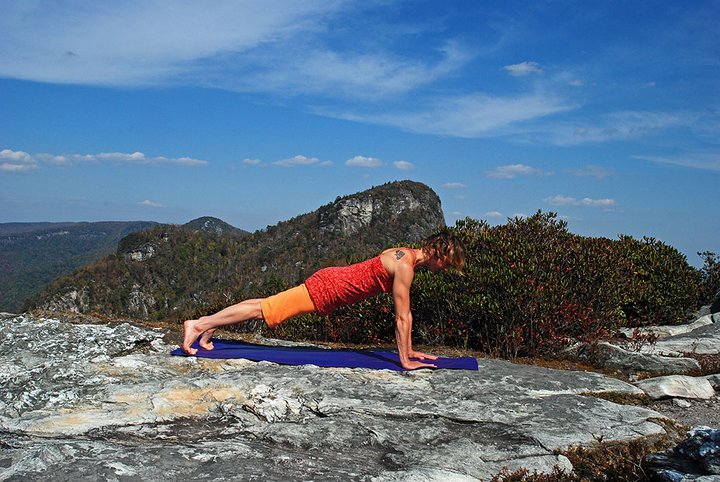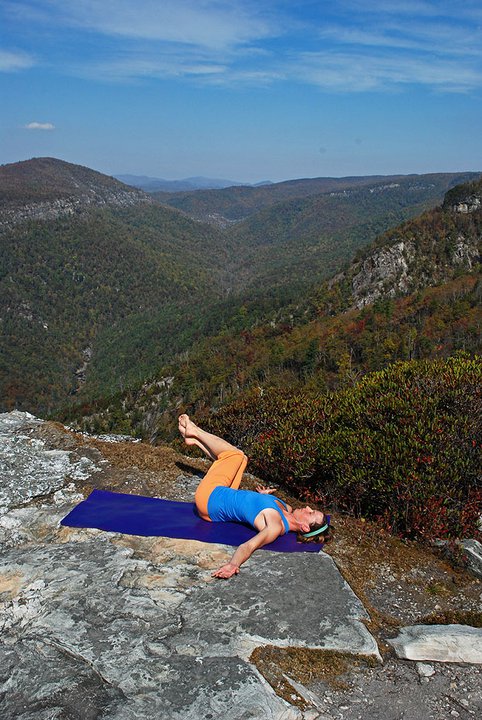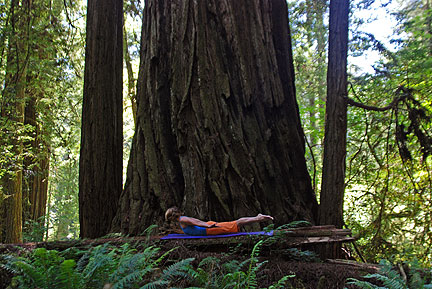Yoga for Boaters' Back Pain
Core strength is your key to relief. In Yoga for Boaters’ Back Pain, Andria Davis shows you how to use yoga to strengthen your body’s core to help prevent back pain from paddling.
Getting to the Core of Paddlers’ Back Pain
Most paddlers have some form of back pain, and it’s no wonder, because paddling demands a lot from our backs! There are many reasons for back pain, so it’s best and safest to check with a doctor before beginning a home care routine. Mainly, you need to know if you have something wrong with a disc because every movement can make it worse. Besides disc problems, boaters’ back pain can be caused by weak and imbalanced core muscles, tight hip flexors, strained back muscles, sacroiliac dysfunction (problems with the joint where your spine connects to your pelvis), and tight hip and buttock muscles.
Many boaters have some or all of these issues, and they can be interrelated, so it’s always difficult to answer when people want to know how to treat back pain. Let’s start with the problem that boaters never think they have: weak and imbalanced core muscles. The meaning of “core” varies depending on who you talk to and the type of activity involved. For boating, I think the core is best defined as the muscles of the abdomen, lower back and spine, as well as the hip flexors.
Many paddlers think they have a strong core because they do abdominal workouts and/or paddle, but I have found this to be untrue. Paddling and most abdominal workouts primarily strengthen the rectus abdominus (RA), hip flexors (the muscles that bring your legs to your torso—especially important for boofing), and obliques. However, the core muscle that will save your back, and which most often needs strengthening, is the transverse abdominus (TA). The TA is a deep muscle that starts at the pelvic floor, encases your abdominal organs, and then attaches to your diaphragm at the bottom of your rib cage. Unlike the RA and hip flexors, which are called power muscles, the TA is a stabilizing muscle. (The obliques are both power and stabilizing muscles.) Your body will function at its best if the stabilizing and power muscles are balanced so that they can each do their job. If your power muscles have to do both, which is the case for many boaters, then your joints will be less stable and you’ll have less power for paddling. This muscular imbalance oftentimes causes injury.
Paddlers’ bodies often have a hard, strong outer layer of abdominal and hip muscles coupled with a weak TA (and often weak back muscles as well). As we kayak, the spine is not braced well enough. This can wear down your spine, discs, and sacroiliac (SI) joints over time. So, we paddlers need to learn how to strengthen the TA so that it can hold our spine more stable and free our power muscles to fire it up. Then we can hopefully get rid of most back pain and have more strength in our paddling! (I say “most” back pain because there is probably more than one reason for your back pain, and working the core is just one facet of a program to get rid of back pain).
Since the TA is not a hip or torso flexor, it is not adequately exercised by sit-ups, crunches, or reverse crunches. That’s not to say that these exercises aren’t good for you and your paddling—they certainly are! However, you need to work a few other exercises into your routine to work the TA, so I’m going to show you some helpful yoga poses to incorporate into your workouts. Once you strengthen the TA muscle, you will learn to engage it in other exercises, and it will also begin to help you in many aspects of paddling. Having this deeper core strength will not only help your actual paddling, it will also help in lifting your boat over your head to load it and emptying it out on the river, etc.
Strengthening the Transverse Abdominus (TA)
But before we get to the exercises, let’s talk about some important concepts to keep in mind. One way to make sure that you are engaging your TA in all of your abdominal work is to pay attention to your rib cage. It’s important to keep the rib cage still, but not so much that you cause rigidity in your body or shallow breathing. Do not let the rib cage become involved and thrust during your exercises.
Engaging and working the TA is very subtle. When you’re exercising it, you need to learn the difference between strength and rigidity. If you make your body rigid, you will not build strength. The difference in strength and rigidity in your actions is the difference between engaging your muscles versus gripping your muscles. When you grip your muscles, you’re actions are forceful and rigid and your energy is wasted; but when you engage your muscles, your actions are relaxed and fluid and your energy is effective. The easiest way to tell if you’re gripping is to check for tension in other areas of your body, such as your shoulders, jaws, and face.
Another very effective way to tell if you’re gripping your muscles is to check your breathing. The TA is closely connected to your breathing, because the muscle is attached to the diaphragm—a muscle at the bottom of your rib cage that allows you to breathe. To build strength rather than rigidity in the TA, avoid shallow and tense breathing and breathe fully.
Besides the TA, boaters still need to work out the rectus abdominus, the obliques, and the hip flexors. There could be muscular imbalances in these large, powerful muscles that are causing back pain. Exercising these muscles outside of boating will help your body tremendously.
Developing a Yoga Routine for Core Strength
Small backbends in yoga are great to include in a core routine. These exercises not only stretch the abs and hip flexors to take pressure off of your spine by re-aligning the pelvis, but they also exercise those often forgotten muscles on your back. Even though you don’t think about them much, they work very hard to both stabilize and move your spine while paddling.
A core yoga program for boaters not only strengthens the muscles, but stretches them too. Boating of all types requires that our mid-section, back, and spine stretch and twist, so I have also included my favorite pose to help you stretch your mid-section appropriately for paddling—the locust.
Remember, the point of doing a yoga practice is to learn to move your body as a whole; it’s a holistic practice. Pay attention not only to what is happening in your middle, but also to your shoulders, your legs, your spine, and your face. If you pay attention to what’s happening, you will learn to move more efficiently. This holistic aspect is why I mainly choose yoga as my off-river exercise. Yoga teaches me to move my whole body—like a dance—and it feels therapeutic. I imagine this is why CrossFit has become a popular cross-training routine for paddlers. So, whatever you like to do off-river for exercise, these few yoga exercises can be incorporated to help you learn alignment and balance and help you feel and understand more of what is happening in your body.
Yoga Poses for Better Core Strength
Tips to keep in mind while doing these poses:
Focus on feeling what’s going on in your body rather than trying to force big movements, paying attention to your whole body, and BREATHE.
If these poses cause any sharp pains, back out of the pose until you no longer feel pain. Only work in a pain-free range of motion.
Hold the poses for as long as you can breathe comfortably, and repeat them as often as you like. However, don’t burn yourself out the day before a big paddling weekend! If you do a big workout, give yourself a rest day before paddling.
Plank Pose

This is the classic core exercise. If your shoulders hurt or pinch, start by doing the shoulder exercise from my article Yoga for Boaters’ Shoulder Pain. If you want to spice it up, or if the pose hurts your wrists, do the plank pose on your forearms.
Start on your hands and knees (tabletop pose). Lift your knees off the ground and straighten your legs behind you so that your body looks like a plank. Push back through your heels. Push up with your abs, particularly at the bottom of your rib cage. Make sure you breathe.
If this pose hurts your wrists, it often means they are not flexible enough to put weight on them in that position. You can hang out in the tabletop pose to work on wrist flexibility. Wrist pain can also mean that you have shoulder issues, so I recommend working on shoulder function. It can also mean that you have weak core strength. If so, you can do the pose with your knees down and work your way up.
Boat Pose

This pose mainly strengthens your hip flexors, but it also requires your TA for balance. If your TA can keep you stable, your hip flexors can focus on bringing your legs up and keeping them there.
Begin sitting with your legs bent in front of you and your feet flat on the floor. Lift inward and upward with the inner thighs, pelvic floor and navel. Lift up through your spine and the crown of your head. Broaden your collarbones and draw your shoulder blades down your back.
Using your hands on the floor next to your hips for balance, exhale and lift your feet off the floor. If you need more challenge, lift your hands and straighten your arms in front of you. Lift up with the back body as much as with the front body. Keep your collarbones broad, relax your face and jaws, and breathe evenly.
To take it all the way, straighten your legs. (Only do this if your legs and hips are flexible enough! To know, ask yourself if you can bend forward this far in a seated forward bend or a standing forward bend.)
Supine Twist

This exercise is fabulous for both strengthening and stretching your obliques and many other muscles of the torso and spine. It causes an “eccentric contraction”—an active stretch—which is exactly what your muscles are doing while paddling.
Lie supine with your arms out at your sides and your palms facing up so that your body makes a “T”. Bend your knees and bring your legs up to a 90-degree angle from your body, being sure not to arch your back or rib cage. Exhale as you slowly lower your legs to one side. Only go as far as you can with no pain and without lifting your opposite shoulder off the floor. Do not rest the legs. Hang out for as long as possible and breathe. When you’re ready, inhale to come up and exhale to the other side.
Locust Pose

This pose stretches the muscles of the front body and strengthens the muscles in the back of your body to help you bring balance back to your structure and hopefully ease back pain.
Lie in a prone position with your forehead on the floor, your feet about hip-width apart, and your arms by your sides with your palms facing up. Take a deep breath and release all tension. Inhale as you lift your legs, torso, and arms. Keep the head in line with the spine and shift your gaze upward. Release tension from your face and jaws. Breathe fully. Exhale and slowly come down, then release completely into the floor.